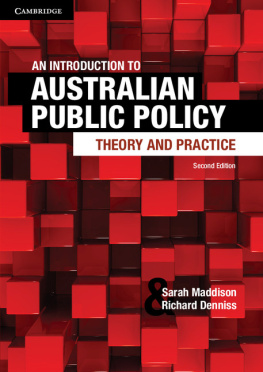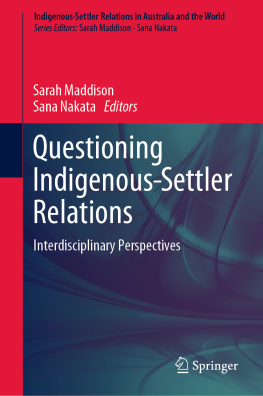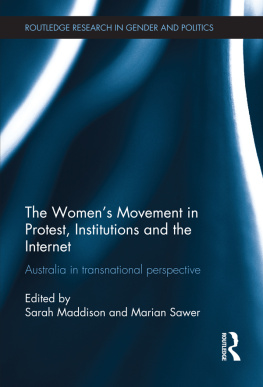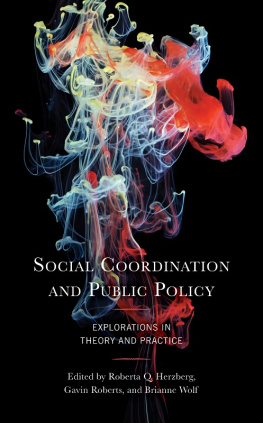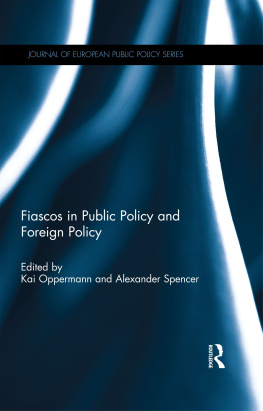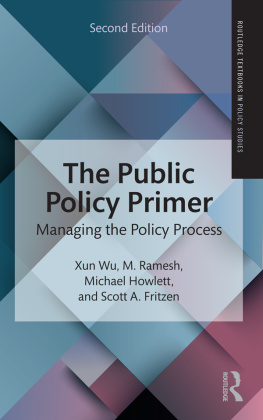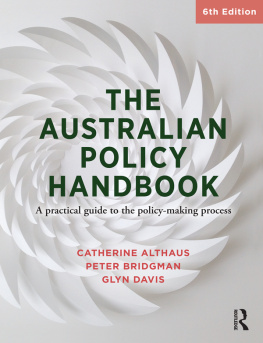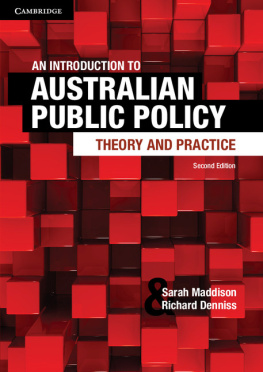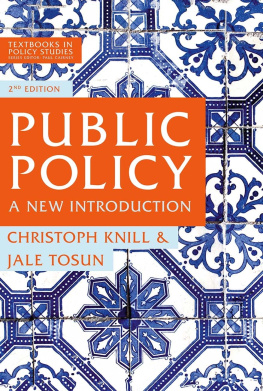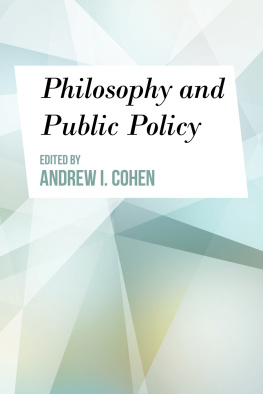
An Introduction to Australian Public Policy
Theory and Practice
Second edition
The public policy arena is a complex framework of actors, politics and instruments. An Introduction to Australian Public Policy Second Edition examines the broad range of models, influences and players that shape the development of public policy in Australia. It equips students with a working knowledge of both the theoretical underpinnings and real-world challenges of the field. Fully revised and updated, this new edition of Sarah Maddison and Richard Denniss comprehensive overview of policy making in Australia addresses the diverse approaches to policy formulation required by different practitioners and institutions.
Fully revised and updated, this new edition of Sarah Maddison and Richard Denniss comprehensive overview of policy making in Australia addresses the diverse approaches to policy formulation required by different practitioners and institutions.
Accessible and engaging, this edition includes:
- a new chapter on policy evaluation
- practical exercises on how to write policy briefs and media releases
- eleven new, concise case studies from Australias top public policy practitioners, examining contemporary issues such as carbon emissions, the mining tax, GetUp! and the 2012 aged care reforms.
The book is accompanied by a companion website at www.cambridge.edu.au/academic/publicpolicy, which contains chapter summaries, discussion questions and a glossary.
Widely regarded as the best introduction to public policy available, An Introduction to Australian Public Policy is an essential resource for undergraduate students of politics, policy workers and anyone with an interest in understanding public policy discourse in Australia.
SARAH MADDISON is Associate Professor and Australian Research Council Future Fellow in the Faculty of Arts and Social Sciences at the University of New South Wales.
RICHARD DENNISS is Executive Director of the Australia Institute, a Canberra-based policy think tank, and Adjunct Associate Professor in the Crawford School of Economics and Government at the Australian National University.
An Introduction to Australian Public Policy
Theory and Practice
Second Edition
Sarah Maddison
Richard Denniss
477 Williamstown Road, Port Melbourne, VIC 3207, Australia
Published in the United States of America by Cambridge University Press, New York
Cambridge University Press is part of the University of Cambridge
It furthers the Universitys mission by disseminating knowledge in the pursuit of education, learning, and research at the highest international levels of excellence.
www.cambridge.org
Information on this title: www.cambridge.org/9781107658257
Cambridge University Press 2013
This publication is copyright. Subject to statutory exception and to the provisions of relevant collective licensing agreements, no reproduction of any part may take place without the written permission of Cambridge University Press.
First published 2009
Reprinted 2011
Second edition 2013
Reprinted 2014
Cover design by Sardine Design
Typeset by Integra Software Services Pvt. Ltd
Printed in China by C & C Offset Printing Co. Ltd
A catalogue record for this publication is available from the British Library
A Cataloguing-in-Publication entry is available from the catalogue of the National Library of Australia at www.nla.gov.au
ISBN 978-1-107-65825-7 Paperback
Additional resources for this publication at www.cambridge.edu.au/academic/publicpolicy
Reproduction and communication for educational purposes
The Australian Copyright Act 1968 (the Act) allows a maximum of one chapter or 10% of the pages of this work, whichever is the greater, to be reproduced and/or communicated by any educational institution for its educational purposes provided that the educational institution (or the body that administers it) has given a remuneration notice to Copyright Agency Limited (CAL) under the Act.
For details of the CAL licence for educational institutions contact:
Copyright Agency Limited
Level 15, 233 Castlereagh Street
Sydney NSW 2000
Telephone: (02) 9394 7600
Facsimile: (02) 9394 7601
E-mail: info@copyright.com.au
Cambridge University Press has no responsibility for the persistence or accuracy of URLs for external or third-party internet websites referred to in this publication and does not guarantee that any content on such websites is, or will remain, accurate or appropriate.
Foreword
Policy is where ideas meet action. That is why policy makers need to grapple with both theory and practice. This book provides the foundation upon which students and practitioners alike can analyse the policy process as it is and create the policy process that there should be.
Sarah Maddison and Richard Denniss both have extensive experience not just in researching and teaching the policy process, but also in participating in it, and this breadth of experience defines the approach taken throughout this book. while some chapters are more about theory and others focus more on practice, both elements are interwoven throughout. The book exposes students to the big ideas about policy, but never steers them too far away from the need to develop policy in the real world.
This second edition has been extensively updated and is based on new examples and new evidence. It now includes a chapter dedicated to the task of policy evaluation and is linked to a new website with up-to-date case studies, chapter summaries, links to additional sources, and a flashcard glossary.
Professor Allan Fels , AO
Dean
The Australia and New Zealand School of Government (ANZSOG)
Figures
Tables
Case studies, exercises and original contributions
Case studies
Exercises
Original contributions
Part 1 Policy and Theory
Introduction
Why study policy?
Anyone interested in politics needs to understand how political decisions are made. Behind what we hear described as policy on the nightly news and what we read about in the newspaper is a complex process involving a range of players with competing interests, facing an array of pressures. These players may be inside or outside of government, and inside or outside of the bureaucracy. They may come from industry, the not-for-profit non-government sector, unions, professional bodies or from academia. Understanding the way these players interact, what drives and informs them, how they think, and what they do, helps us all to understand and interpret the policies that these complex relationships eventually produce: policies that have implications for each of us in our daily lives. Policy determines where roads are built, how many nurses work in a hospital, what fees you pay at university, how much tax we pay, the price of child care and so on and so on. Policy goes beyond measures of efficiency, effectiveness and political feasibility, with demonstrable effects on citizenship, justice, discourse and democracy (Ingram & Schneider : 169). Almost every aspect of our lives is touched by policy. If we understand how policy is made we have greater capacity to participate in that process, to have our voices heard and to influence decisions. This book will provide students of policy with both a theoretical understanding of public policy and an introduction to some of the real-world challenges and skills involved in working in a range of policy roles.

